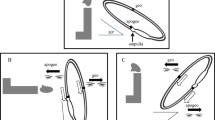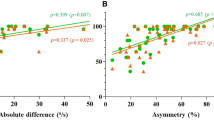Abstract
Objective
The purpose of the study was to evaluate the efficiency of the supine roll test (SRT) and alternative positional tests (APTs) including the bow and lean test (BLT), pseudo-spontaneous nystagmus (PSN), and lying down nystagmus (LDN) to identify the affected side in horizontal canal benign paroxysmal positional vertigo (HC-BPPV).
Methods
In our prospective study, we performed a testing profile (PSN, BLT, LDN, SRT) on 59 HC-BPPV patients using videonystagmography. We compared the accuracy and sensitivity of these tests in HC-BPPV lateralization. Data from 30 healthy patients were collected as the control group.
Results
When performing positional tests, the elicited nystagmus coinciding with Ewald’s second law was defined as a “positive response”. In 44 patients with geotropic nystagmus, the rates of positive response in LDN, PSN, and BLT were 22/44 (50%), 19/44 (43%), and 18/44 (41%), respectively, while in 15 patients with apogeotropic nystagmus, the positive response rates of these three tests were 10/15 (66.7%), 9/15 (60%), and 4/15 (27.00%), respectively. The sensitivity of LDN (54.38%) was higher than that of PSN (47.37%) and BLT (38.60%) but lower than that of SRT (89.47%). Notably, the accuracy rate of PSN (71.8%) was higher than that of the other APTs. In 6 patients with symmetrical nysgtamus during the roll test, 5 patients showed a positive response in both LDN and BLT (83.34%), whereas 4 patients showed a positive response in PSN (66.67%).
Conclusion
All positional tests are helpful for determining the affected side of HC-BPPV, but SRT carries the highest accuracy of lateralization followed by PSN.
Similar content being viewed by others
References
Lee SH, Kim JS. Benign paroxysmal positional vertigo. J Clin Neurol, 2010,6(2):51–63
Dispenza F, Stefano A DE, Costantino C, et al. Canal switch and re-entry phenomenon in benign paroxysmal positional vertigo: difference between immediate and delayed occurrence. Acta Otorhinolaryngol Ital, 2015,35(2):116–120
Aron M, Bance M. Insights into horizontal canal benign paroxysmal positional vertigo from a human case report. Laryngoscope, 2013,123(12):3197–3200
Pagnini P, Nuti D, Vannucchi P. Benign paroxysmal vertigo of the horizontal canal. ORL J Otorhinolaryngol Retal Spec, 1989,51(3):161–170
Korres SG, Balastsouras DG. Diagnostic, pathophysiologic, and therapeutic aspects of benign paroxysmal positional vertigo. Otolaryngol Head Neck Surg, 2004,131(4):438–444
Choung YH, Shin YR, Kahng H, et al. ‘Bow and lean test’ to determine the affected ear of horizontal canal benign paroxysmal positional vertigo. Laryngoscope, 2006,116(10):1776–1781
Asprella-Libonati G. Pseudo-spontaneous nystagmus: a new sign to diagnose the affected side in lateral semicircular canal benign paroxysmal positional vertigo. Acta Otorhinolaryngol Ital, 2008,28(2):37–38
Koo JW, Moon IJ, Shin WS, et al. Value of lying-down nystagmus in the lateralization of horizontal semicircular canal benign paroxysmal positional vertigo. Otol Neurotol, 2006,27(3):367–371
Califano L, Melillo MG, Mazzone S, et al. “Secondary signs of lateralization” in apogeotropic lateral canalilithiasis. Acta Otorhinolargngol Ital, 2010,30(2):78–86.
Lee SH, Choi KD, Jeing SH, et al. Nystagmus during neck flexion in the pitch plane in benign paroxysmal positional vertigo involving the horizontal canal. J Neurol Sci, 2007,256(1–2):75–80
Oh JH, Song Sk, Lee JS, et al. Lying down nystagmus and head-beinding nystagmus in horizontal semicircular canal benign paroxysmal positional vertigo: are they useful for lateralization? BMC Ophthalmol, 2014,14:136
Lee SU, Kim HJ, Kim JS. Pseudo-spontaneous and head-shaking nystagmus in horizontal canal benign paroxysmal positional vertigo. Otol Neurotol, 2014, 35:495–500
Nuti D, Vannuchhi P, Pagnini P. Benign paroxysmal positional vertigo of the horizontal canal: a form of canalolithiasis with variable clinical features. J Vestib Res, 1996,6(3):173–184
Kim CH, Kim YG, Shin JE, et al. Lateralization of horizontal semicircular canal canalolithiasis and cupulopathy using now and lean test and head-roll test. Eur Arch Otorhinolaryngol, 2016,273(10):3003–3009
Nuti D, Mandala M, Salerni L. Lateral canal paroxysmal positional vertigo revisited. Ann N Y Acad Sci, 2009, 1164:316–323
Asprella-Libonati G. Nystagmus while recumbent in horizontal canal benign paroxysmal positional vertigo. Neurology, 2006,67(9):1723–1724
Han BI, Oh HJ, Kim JS. Nystagmus while recumbent in horizontal canal benign paroxysmal positional vertigo. Neurology, 2006,66(5):706–710
Nuti D, Aug G, Barbieri MT, et al. The management of horizontal-canal benign paroxysmal positional vertigo. Acta Otolaryngol, 1998,118(4):455–460
Casani AP, Vannucci G, Fattori B, et al. The treatment of horizontal canal benign paroxysmal positional vertigo: our experience in 66 cases. Laryngoscope, 2002,112(1): 172–178
Lee JB, Han DH, Choi SJ, et al. Efficacy of the “bow and lean test” for the management of horizontal canal benign paroxysmal positional vertigo. Laryngoscope, 2010,120(11):2339–2346
Hain TC, Squires TM, Stone HA. Clinical Implication of a Mathematical Model of Benign Paroxysmal Positional Vertigo. Ann N Y Acad Sci, 2005,1039:384–394
Bisdorff AR, Debatise D. Localising signs in positional vertigo due to lateral canal cupulolithiasis. Neurology, 2001,57(6):1085–1088
Alfonso S, Claudia C, Federico MG, et al. Lateralization of horizontal semicircular canal benign paroxysmal positional vertigo (HSC-BPPV) with the latency test: a pilot study. Acta Oto-Laryngologica, 2019,139(10):854–859
Choi S, Choi HR, Nahm H, et al. Utility of the bow and lean test in predicting subtype of benign paroxysmal positional vertigo. Laryngoscope, 2018,128(11):2600–2604
Pasquale M, Andrea C, Salvatore M, et al. Upright head roll test: A new contribution for the diagnosis of lateral semicircular canal benign paroxysmal positional vertigo. Audio Res, 2020,10(1):236
Salvatore M, Pasquale M, Andrea C, et al. Upright BPPV protocol: feasibility of a new diagnostic paradigm for lateral semicircular canal- benign paroxysmal positional vertigo compared to standard diagnostic maneuvers. Front Neurol, 2020,11:578305
Choo OS, Kim H, Jang JH, et al. Vertical Nystagmus in the Bow and Lean Test may Indicate Hidden Posterior Semicircular Canal Benign Paroxysmal Positional Vertigo:Hypotheis of the Location of Otoconia. Sci Rep, 2020,10(1):6514
Acknowledgments
The authors thank the Department of Audiometry and Vestibular Center of Tongji Hospital for supporting this work.
Author information
Authors and Affiliations
Corresponding author
Additional information
Conflict of Interest Statement
The authors have declared that no competing interests exist. The funders have had no role in study design, data collection and analysis, decision to publish, or preparation of the manuscript.
This work was supported by grants from the National Natural Science Foundation of China (No. 81500794, No. 81271078 and No. 81500791) and Scientific Research Project of Hubei Province Health and Family Planning (No. WJ2015MB062).
Rights and permissions
About this article
Cite this article
Koju, G., Bing, D., Zhou, Lq. et al. Comparisons of Supine Roll Test and Alternative Positional Tests in HC-BPPV Lateralization. CURR MED SCI 42, 613–619 (2022). https://doi.org/10.1007/s11596-022-2562-z
Received:
Accepted:
Published:
Issue Date:
DOI: https://doi.org/10.1007/s11596-022-2562-z




